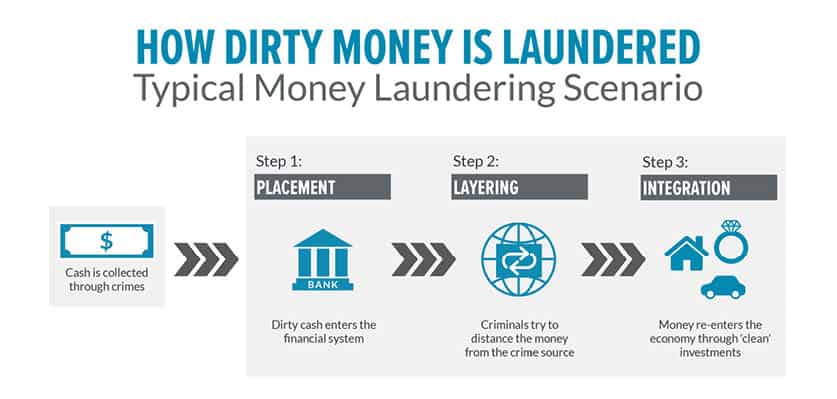Imagine a world where ill-gotten gains vanish into thin air, leaving behind no trace. This is the allure of money laundering, a clandestine operation that transforms dirty money into seemingly legitimate funds. One of the most sophisticated strategies employed by money launderers is layering, a meticulous process designed to obfuscate the origins of illicit funds through a series of complex transactions. This article delves into the intricate world of layering money laundering, unveiling its techniques and revealing how authorities are combating this pervasive financial crime.

Image: www.sanctions.io
Layering money laundering is a multifaceted process that involves a series of intricate transactions, designed to obscure the trails leading back to the original source of the illicit funds. It is akin to an elaborate game of hide-and-seek, where money launderers strategically move funds through various accounts, institutions, and jurisdictions, creating a web of complex transactions that are exceptionally difficult to trace.
Understanding the Layered Approach
The process of layering often involves the following steps:
-
Placement: The initial stage of layering involves the introduction of illicit funds into the financial system. This can occur through various methods, such as depositing small amounts of cash into multiple accounts, utilizing shell companies, or using cash-intensive businesses as fronts.
-
Layering: This is where the true artistry comes into play. Money launderers engage in a series of transactions, often involving multiple intermediaries, to obscure the original source of the funds. These transactions may involve converting cash into other assets, such as securities, real estate, or even precious metals. The money may also be moved between different bank accounts, both domestic and international, often utilizing offshore banking centers known for their privacy laws.
-
Integration: The final stage involves integrating the laundered funds into the legitimate economy. This could involve investing in businesses, purchasing assets, or making large-scale transactions that appear legitimate.
The Real-World Impact of Money Laundering
Money laundering poses a significant threat to global security, undermining the integrity of financial systems and fueling organized crime, terrorism, and corruption. Its impact extends beyond financial markets, affecting various aspects of society:
-
Terrorist Financing: Money laundering becomes a crucial tool for terrorist organizations to acquire funds necessary for planning and carrying out attacks.
-
Human Trafficking: Proceeds from human trafficking, a horrific violation of human rights, often rely on money laundering to disguise the source of income.
-
Corruption: Officials and individuals involved in corrupt practices often use money laundering to hide their illicit gains and evade justice.
Unmasking the Masterminds: Combating Layering
Authorities worldwide are stepping up their efforts to crack down on layering, implementing various strategies to uncover and disrupt money laundering activities:
-
Financial Intelligence Units (FIUs): FIUs are specialized agencies responsible for collecting and analyzing financial intelligence, playing a crucial role in identifying suspicious transactions and tracking money flows.
-
International Cooperation: Collaborating with international partners is essential to combat transnational money laundering schemes, as criminal networks often operate across borders.
-
Anti-Money Laundering (AML) Regulations: Countries have implemented strict AML regulations, requiring financial institutions to verify the identity of their customers, monitor transactions, and report suspicious activity.
-
Technology and Data Analytics: Advancements in technology, including sophisticated data analytics techniques, are providing law enforcement agencies with powerful tools to detect complex transactions and identify patterns indicative of money laundering.
-
Public Awareness: Raising public awareness about money laundering is crucial in promoting vigilance and encouraging individuals to report suspicious activities.

Image: thecrimesbook.blogspot.com
Expert Insights and Actionable Tips
Experts in the field emphasize the importance of a multi-faceted approach to combat money laundering, encompassing collaboration, intelligence sharing, and technological advancements. They stress the significance of engaging the private sector, urging companies to implement robust AML compliance programs and actively participate in the fight against financial crime.
Individuals can also play a role in combating money laundering by being vigilant and reporting any suspicious activities they encounter. This might include unusual transactions, sudden wealth accumulation, or individuals who appear to be hiding their identity or origins.
Layering Money Laundering
Conclusion
Layering money laundering represents a formidable challenge, requiring a coordinated and collaborative approach from governments, law enforcement agencies, financial institutions, and the public. By understanding the techniques employed by money launderers and strengthening our collective efforts to combat this crime, we can protect the integrity of financial systems, disrupt criminal networks, and safeguard the well-being of our communities. Remember, vigilance and collaboration are essential weapons in the fight against money laundering.





